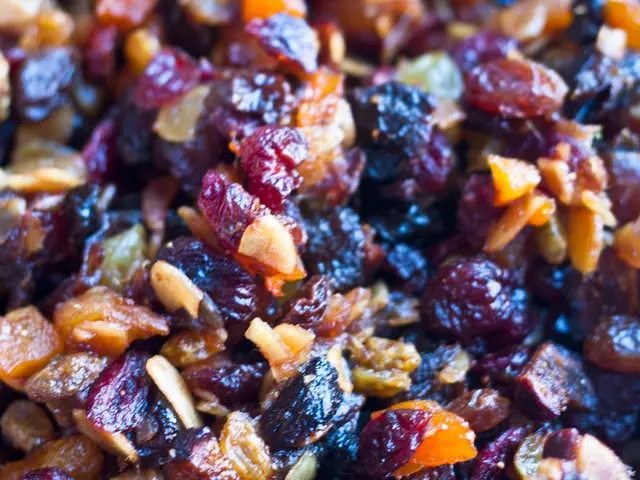Mold on Food: A Harmful Indulgence or Tasteful Risk?
In the world of food, mold can be a common sight, particularly on bread, pastries, and certain cheeses. But not all molds are harmless, and it's essential for consumers to understand how to identify and deal with harmful food molds.
Visible signs of harmful molds include fuzzy or patchy growth in various colours such as white, gray, black, green, or yellow, sliminess, or an off or musty smell on food items [1][3]. It's important to note that not all dangerous molds are visible, and some harmful mycotoxins can be present even without obvious mold [1]. Therefore, any mold on soft or moist foods like bread, yogurt, or cooked leftovers should be considered unsafe as mold can penetrate deeply, spreading toxins and bacteria beyond what is visible [4].
When it comes to hard foods like firm cheeses, carrots, or cabbage, it's sometimes possible to salvage the food by cutting away at least 1 inch around and below the mold spot, ensuring the knife does not touch the mold [4]. However, for safety, many experts recommend discarding moldy soft foods entirely.
Preventing mold growth is key to maintaining food safety. Proper food storage is crucial, storing food in cool, dry places, refrigerating perishable items promptly, and maintaining correct humidity levels to inhibit fungal growth [2][4]. Good hygiene and handling practices are also important, using clean utensils and hands when handling food, and rotating stock regularly to avoid using expired or spoiled items [2].
For food producers, Good Manufacturing Practices (GMPs) are key. Maintaining a clean, sanitary environment, controlling temperature and humidity, and preventing cross-contamination are essential measures [2]. The use of antifungal agents and preservatives can also help. Ingredients like sorbic acid, potassium sorbate, natamycin, and propionic acid can inhibit fungal growth and extend shelf life [2]. These are often combined with other preservation methods such as modified atmosphere packaging.
In summary, visually inspect food for mold and off smells, discard moldy soft foods, and apply proper storage and hygiene practices to prevent mold. Awareness that some molds can produce harmful toxins even without visible signs means erring on the side of caution is safest [1][4].
- Adopting a health-and-wellness lifestyle that prioritizes healthy-cooking practices can help consumers identify and deal with harmful food molds, especially when preparing global cuisines.
- In the realm of science, understanding the role of good manufacturing practices (GMPs) in food production is crucial for creating safe, quality food-and-drink products that are free from mold contamination.
- To maintain a healthy lifestyle, it's essential to focus on more than just cooking and fitness-and-exercise; proper food storage and hygiene are integral factors in promoting food safety and preventing mold growth.
- As the global demand for health-and-wellness products and lifestyle trends continues to rise, the exploration of innovative antifungal agents and preservatives in food-and-drink products is vital for ensuring a longer shelf life and enhanced food safety standards across various lifestyle sectors, including fitness-and-exercise, science, and cooking.




